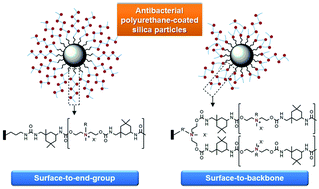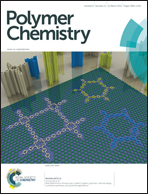Polyurethane-coated silica particles with broad-spectrum antibacterial properties†
Abstract
Antimicrobial polymer-coated silica particles were synthesized using a “grafting to” approach. A number of polyurethanes (PU) and poly(ethylene glycol)-containing polyurethanes (PU-PEG) with and without free isocyanate end groups were synthesized by metal-free organocatalytic polymerization of isophorone diisocyanate and N-methyldiethanolamine in the absence or presence of PEG diol using 1,8-diazabicyclo[5.4.0]undec-7-ene as the catalyst, followed by covalent grafting onto primary amine, propyl chloride or benzyl chloride-functionalized silica particles via both surface-to-end-group (primary amine to isocyanate) and surface-to-backbone (propyl chloride or benzyl chloride to tertiary amine in PU and PU-PEG backbones, which generated quaternary ammoniums) attachment modes, resulting in various structures of the polymer-grafted surface. The free tertiary amine groups in the polymer coatings were quaternized using benzyl bromide or methyl iodide to impart antibacterial function. The samples were characterized by X-ray photoelectron spectroscopy (XPS), while their antibacterial efficacies and killing kinetics against Gram-positive S. aureus and Gram-negative E. coli were investigated. XPS spectra showed that the attachment mode on different types of surface-functionalized silica particles resulted in various degrees of polymer conjugation and subsequently led to varying antibacterial efficacies. The surface-to-end-group attachment mode after post-quaternization, in particular, produced PU-PEG-coated silica particles with excellent antibacterial potency against S. aureus and E. coli at a low particle concentration of 10 and 40 mg mL−1, respectively. By using the same batch of particles in repeated applications, it was found that the antibacterial effectiveness was maintained, and the surface-grafted polymer was stable. Overall, these polymer-coated silica particles have good potential for practical antibacterial applications.

- This article is part of the themed collection: Polymer Chemistry Lectureship Winners

 Please wait while we load your content...
Please wait while we load your content...